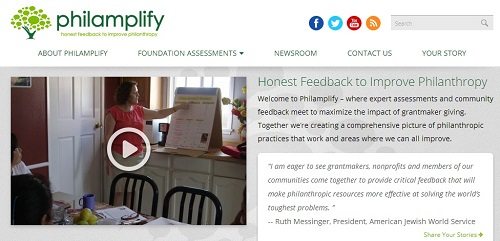
Today, the National Committee for Responsive Philanthropy announced the launch of an interesting and perhaps groundbreaking new product called Philamplify. It’s a modern response to the age-old problem of there being no natural accountability market for philanthropic institutions. The project is aimed at assessing the top 100 foundations (by asset size) in the United States and helping them to learn through a combination of publicly delivered criticisms and kudos.
The website currently features three assessments of large foundations: the William Penn Foundation, the Lumina Foundation, and the Robert W. Woodruff Foundation. The project makes good use of research and technology in identifying and reaching out to foundation stakeholders; as a result, none of these foundations had to be asked if they would allow the exercise. This, in the end, is what could be the intriguing value proposition of the program.
Each of the assessments took eight months to complete, according to Aaron Dorfman, NCRP’s executive director, and they got varying degrees of cooperation from the foundations being reviewed. For instance, although some did share their contacts for grantees, others did not. When they did not share this information, it had to be gathered by hand. But any lack of initial cooperation did not deter the effort, so in the end all three foundations made themselves available for interviews to discuss and clarify any issues and questions raised by the report—because, after all, would it have been wise to not do so?
Sign up for our free newsletters
Subscribe to NPQ's newsletters to have our top stories delivered directly to your inbox.
By signing up, you agree to our privacy policy and terms of use, and to receive messages from NPQ and our partners.
Each report addressed questions of strategy, outcomes and impact, partnership with grantees, and other effective practices, including transparency, investment and payout, and governance. The methodology included a review of foundation materials, interviews with key staff, a confidential survey of current and past grantees, interviews with selected grantees, and interviews with local, regional and national stakeholders. And each also includes key findings and recommendations.
The idea of assessing foundations without their permission and without being under contract with them is both inspired and sorely needed, but there are still inherent structural problems that will need to be overcome for the project to make a significant mark on the philanthropic landscape. The most significant of these potential problems is the revenue model for the sponsoring organization. NCRP is fond of saying that it has specialized in biting the hand that feeds it for four decades, but ideally the managers of such a project would have no financial ties to philanthropy such that they might be punished for being critical. NCRP is funded by philanthropy, and complete independence may be hard to achieve. Dorfman told NPQ that this particular project is not supported by any specific funder, but by the organization’s unrestricted funds. “Our funding comes from institutions who value the role of an independent critic on philanthropy,” he said.
For NCRP, he said, this is a way of getting more specific to the work of foundations. “Too much of what we recommend ends up being experienced as abstract by specific foundations,” he said.” This is a way to look at how social justice philanthropy plays out for them as individual institutions in their communities.”
Philamplify—and we hate the name—appears to be nicely designed for impact in a field where feedback can often be muted; naturally, this blocks accountability, learning, effectiveness, and any number of other valuable organizational characteristics. NPQ is generally a hard sell on new projects to improve philanthropy, but this one, at least in its early stages, seems to hold promise.












